Risk Assessment and Management: A Case Study of BP PLC (LSBM302)
VerifiedAdded on 2022/11/28
|11
|2597
|259
Case Study
AI Summary
This case study examines BP PLC's (British Petroleum) risk management practices, focusing on risk review, monitoring, and communication. The report begins with an introduction to BP, highlighting its global operations and the potential risks it faces, including economic, environmental, and operational risks. It delves into BP's risk assurance processes, describing the types of risks the company encounters and the methods used for risk identification, analysis, evaluation, and treatment. The study further explores BP's risk monitoring practices, emphasizing the importance of continuous assessment and mitigation strategies. The report also covers risk communication and culture within BP, discussing internal control mechanisms, the use of the GRC framework (Governance, Risk management, and Compliance), and the three lines of defense model. It concludes by emphasizing the need for BP to prioritize risk management, recommending strategies such as risk avoidance, adherence to risk management processes, and the adoption of best practices to protect the company and its stakeholders. The case study offers a comprehensive overview of BP's approach to managing various types of risk, including financial, environmental, and operational risks, and provides recommendations for improvement.
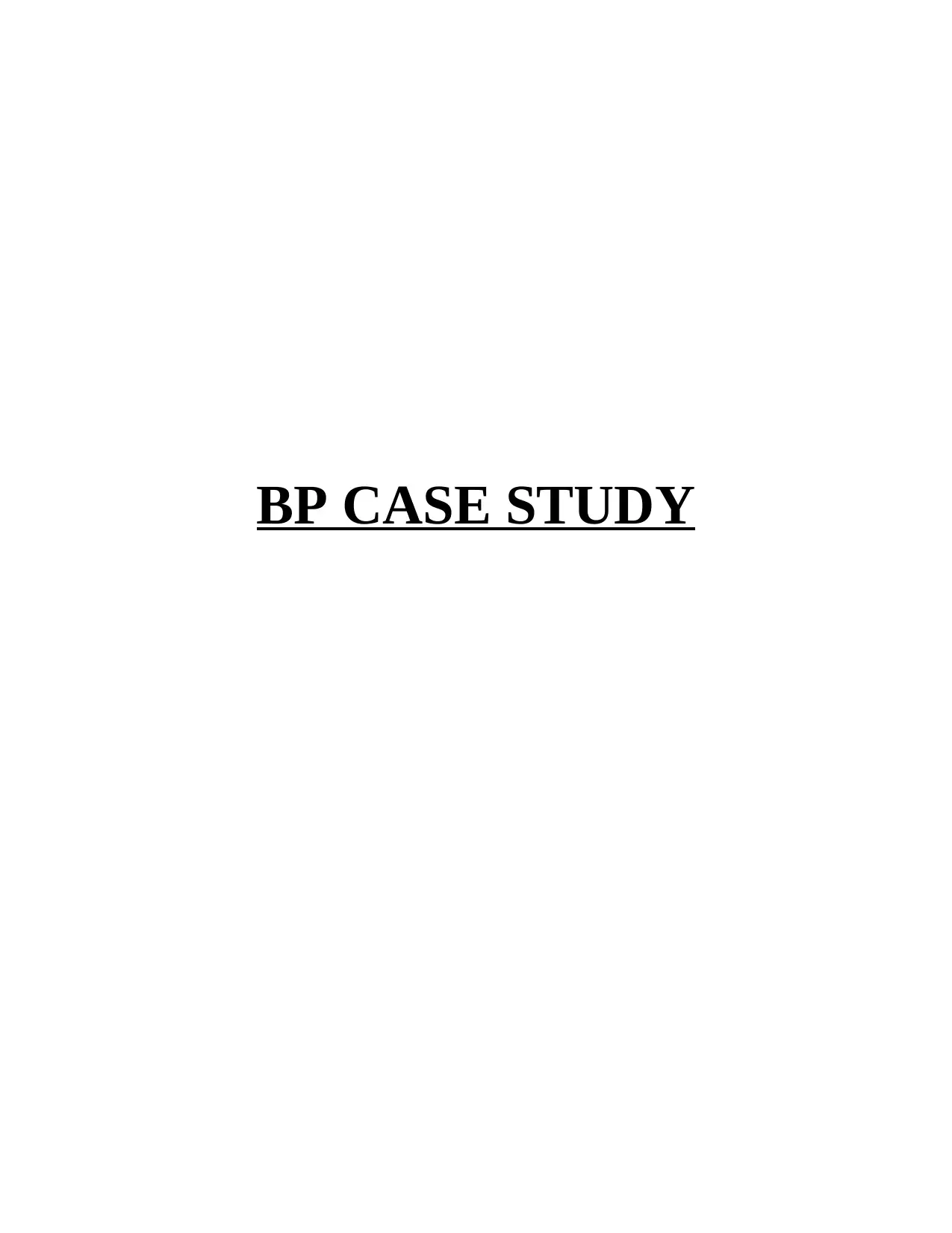
BP CASE STUDY
Paraphrase This Document
Need a fresh take? Get an instant paraphrase of this document with our AI Paraphraser
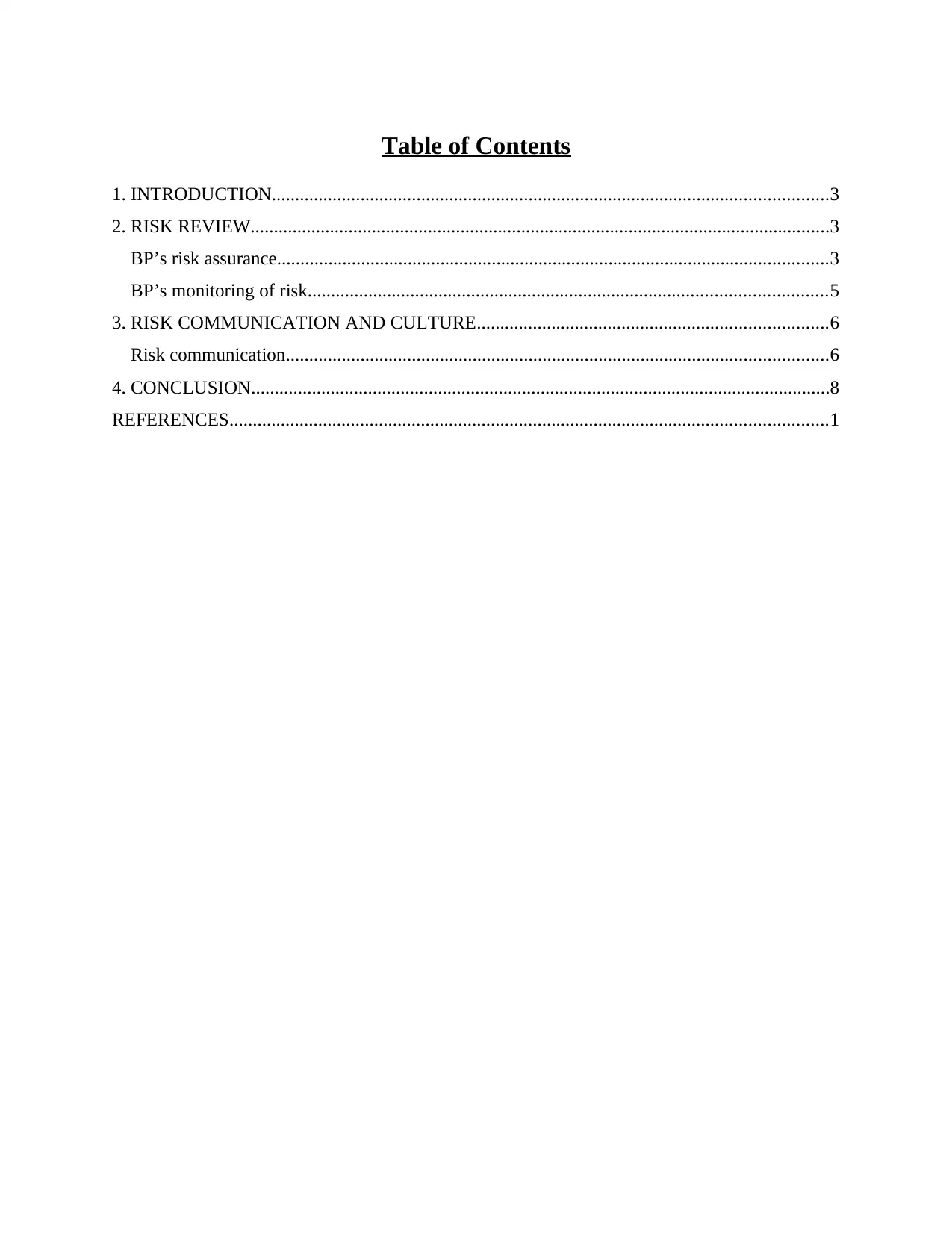
Table of Contents
1. INTRODUCTION.......................................................................................................................3
2. RISK REVIEW............................................................................................................................3
BP’s risk assurance......................................................................................................................3
BP’s monitoring of risk...............................................................................................................5
3. RISK COMMUNICATION AND CULTURE...........................................................................6
Risk communication....................................................................................................................6
4. CONCLUSION............................................................................................................................8
REFERENCES................................................................................................................................1
1. INTRODUCTION.......................................................................................................................3
2. RISK REVIEW............................................................................................................................3
BP’s risk assurance......................................................................................................................3
BP’s monitoring of risk...............................................................................................................5
3. RISK COMMUNICATION AND CULTURE...........................................................................6
Risk communication....................................................................................................................6
4. CONCLUSION............................................................................................................................8
REFERENCES................................................................................................................................1
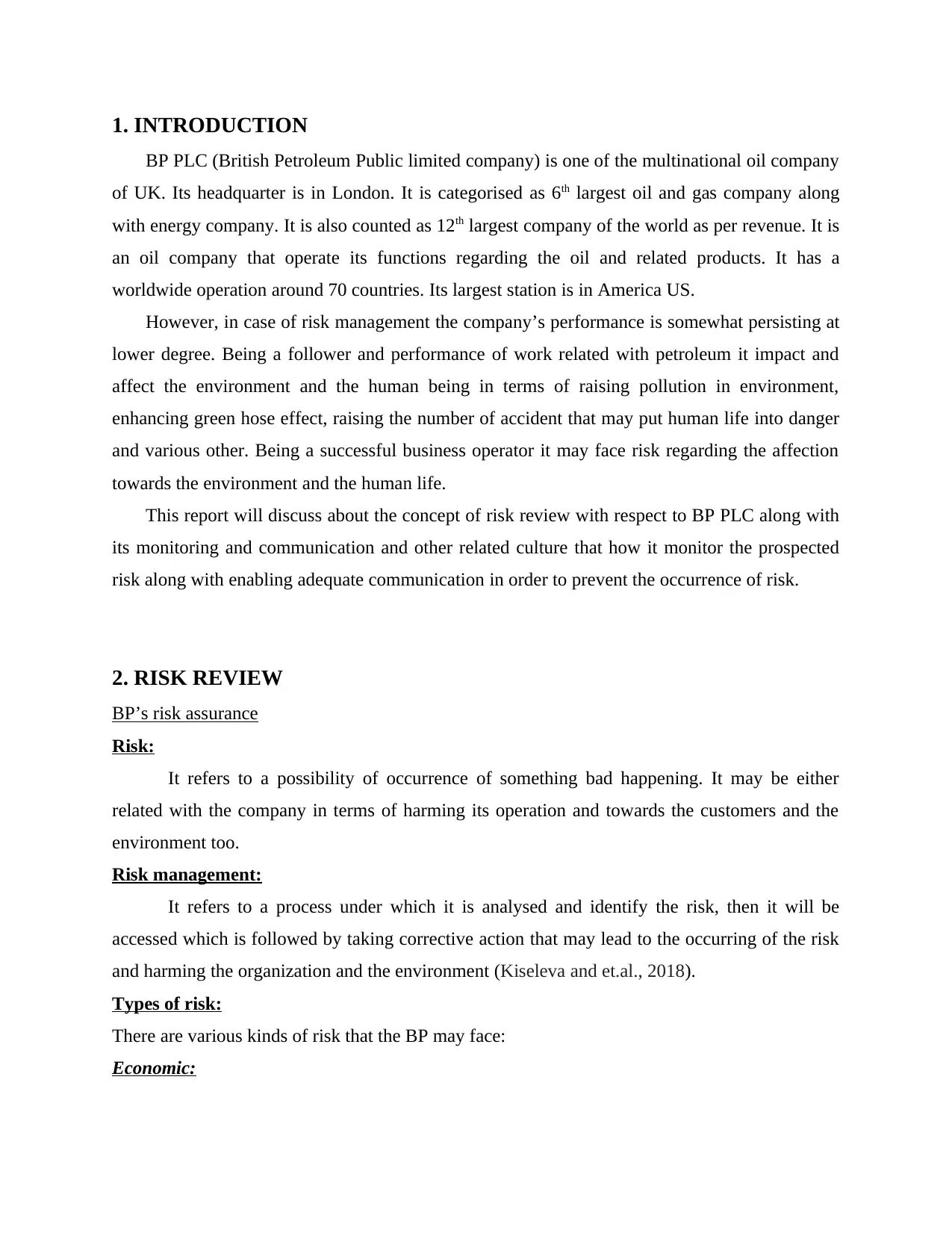
1. INTRODUCTION
BP PLC (British Petroleum Public limited company) is one of the multinational oil company
of UK. Its headquarter is in London. It is categorised as 6th largest oil and gas company along
with energy company. It is also counted as 12th largest company of the world as per revenue. It is
an oil company that operate its functions regarding the oil and related products. It has a
worldwide operation around 70 countries. Its largest station is in America US.
However, in case of risk management the company’s performance is somewhat persisting at
lower degree. Being a follower and performance of work related with petroleum it impact and
affect the environment and the human being in terms of raising pollution in environment,
enhancing green hose effect, raising the number of accident that may put human life into danger
and various other. Being a successful business operator it may face risk regarding the affection
towards the environment and the human life.
This report will discuss about the concept of risk review with respect to BP PLC along with
its monitoring and communication and other related culture that how it monitor the prospected
risk along with enabling adequate communication in order to prevent the occurrence of risk.
2. RISK REVIEW
BP’s risk assurance
Risk:
It refers to a possibility of occurrence of something bad happening. It may be either
related with the company in terms of harming its operation and towards the customers and the
environment too.
Risk management:
It refers to a process under which it is analysed and identify the risk, then it will be
accessed which is followed by taking corrective action that may lead to the occurring of the risk
and harming the organization and the environment (Kiseleva and et.al., 2018).
Types of risk:
There are various kinds of risk that the BP may face:
Economic:
BP PLC (British Petroleum Public limited company) is one of the multinational oil company
of UK. Its headquarter is in London. It is categorised as 6th largest oil and gas company along
with energy company. It is also counted as 12th largest company of the world as per revenue. It is
an oil company that operate its functions regarding the oil and related products. It has a
worldwide operation around 70 countries. Its largest station is in America US.
However, in case of risk management the company’s performance is somewhat persisting at
lower degree. Being a follower and performance of work related with petroleum it impact and
affect the environment and the human being in terms of raising pollution in environment,
enhancing green hose effect, raising the number of accident that may put human life into danger
and various other. Being a successful business operator it may face risk regarding the affection
towards the environment and the human life.
This report will discuss about the concept of risk review with respect to BP PLC along with
its monitoring and communication and other related culture that how it monitor the prospected
risk along with enabling adequate communication in order to prevent the occurrence of risk.
2. RISK REVIEW
BP’s risk assurance
Risk:
It refers to a possibility of occurrence of something bad happening. It may be either
related with the company in terms of harming its operation and towards the customers and the
environment too.
Risk management:
It refers to a process under which it is analysed and identify the risk, then it will be
accessed which is followed by taking corrective action that may lead to the occurring of the risk
and harming the organization and the environment (Kiseleva and et.al., 2018).
Types of risk:
There are various kinds of risk that the BP may face:
Economic:
⊘ This is a preview!⊘
Do you want full access?
Subscribe today to unlock all pages.

Trusted by 1+ million students worldwide
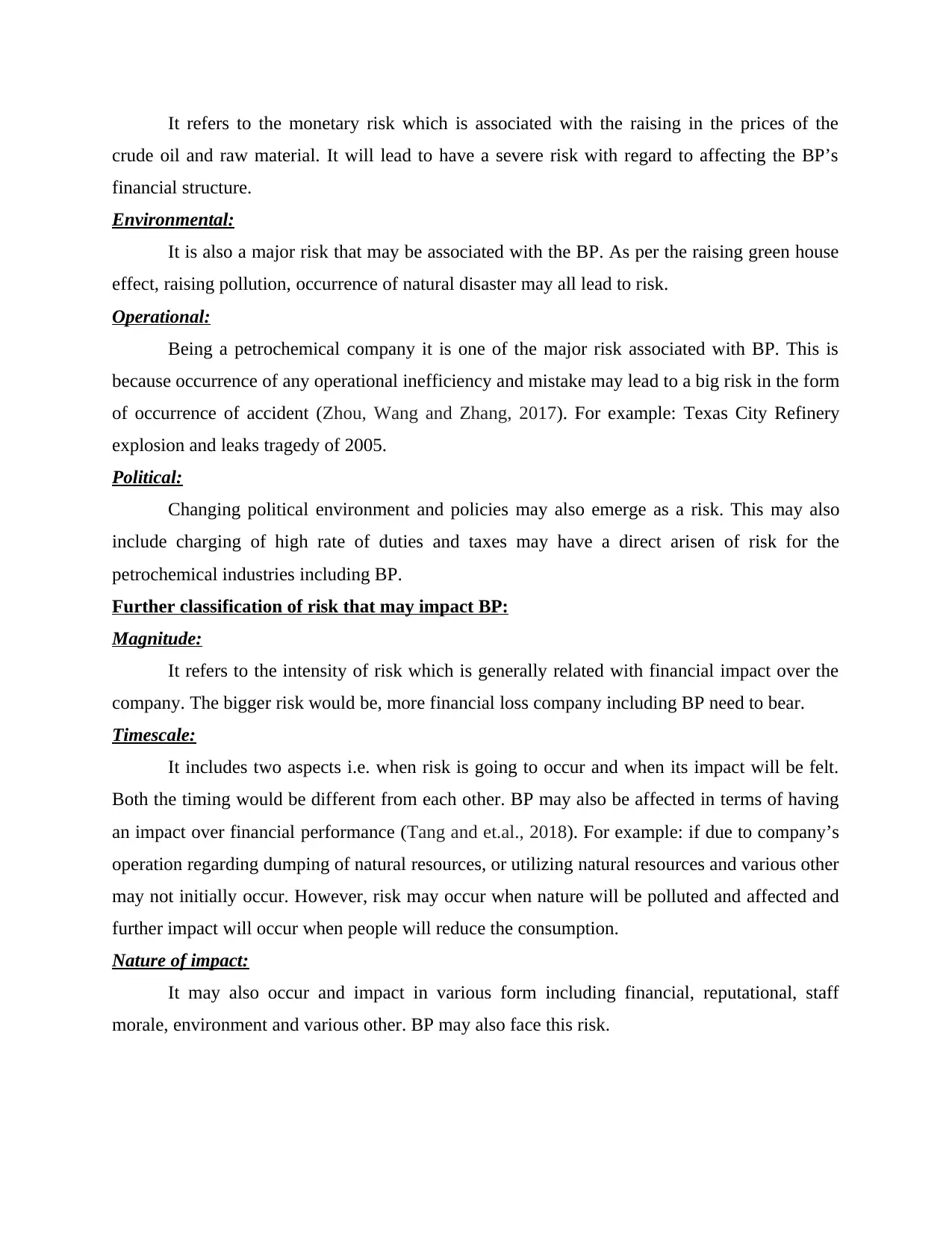
It refers to the monetary risk which is associated with the raising in the prices of the
crude oil and raw material. It will lead to have a severe risk with regard to affecting the BP’s
financial structure.
Environmental:
It is also a major risk that may be associated with the BP. As per the raising green house
effect, raising pollution, occurrence of natural disaster may all lead to risk.
Operational:
Being a petrochemical company it is one of the major risk associated with BP. This is
because occurrence of any operational inefficiency and mistake may lead to a big risk in the form
of occurrence of accident (Zhou, Wang and Zhang, 2017). For example: Texas City Refinery
explosion and leaks tragedy of 2005.
Political:
Changing political environment and policies may also emerge as a risk. This may also
include charging of high rate of duties and taxes may have a direct arisen of risk for the
petrochemical industries including BP.
Further classification of risk that may impact BP:
Magnitude:
It refers to the intensity of risk which is generally related with financial impact over the
company. The bigger risk would be, more financial loss company including BP need to bear.
Timescale:
It includes two aspects i.e. when risk is going to occur and when its impact will be felt.
Both the timing would be different from each other. BP may also be affected in terms of having
an impact over financial performance (Tang and et.al., 2018). For example: if due to company’s
operation regarding dumping of natural resources, or utilizing natural resources and various other
may not initially occur. However, risk may occur when nature will be polluted and affected and
further impact will occur when people will reduce the consumption.
Nature of impact:
It may also occur and impact in various form including financial, reputational, staff
morale, environment and various other. BP may also face this risk.
crude oil and raw material. It will lead to have a severe risk with regard to affecting the BP’s
financial structure.
Environmental:
It is also a major risk that may be associated with the BP. As per the raising green house
effect, raising pollution, occurrence of natural disaster may all lead to risk.
Operational:
Being a petrochemical company it is one of the major risk associated with BP. This is
because occurrence of any operational inefficiency and mistake may lead to a big risk in the form
of occurrence of accident (Zhou, Wang and Zhang, 2017). For example: Texas City Refinery
explosion and leaks tragedy of 2005.
Political:
Changing political environment and policies may also emerge as a risk. This may also
include charging of high rate of duties and taxes may have a direct arisen of risk for the
petrochemical industries including BP.
Further classification of risk that may impact BP:
Magnitude:
It refers to the intensity of risk which is generally related with financial impact over the
company. The bigger risk would be, more financial loss company including BP need to bear.
Timescale:
It includes two aspects i.e. when risk is going to occur and when its impact will be felt.
Both the timing would be different from each other. BP may also be affected in terms of having
an impact over financial performance (Tang and et.al., 2018). For example: if due to company’s
operation regarding dumping of natural resources, or utilizing natural resources and various other
may not initially occur. However, risk may occur when nature will be polluted and affected and
further impact will occur when people will reduce the consumption.
Nature of impact:
It may also occur and impact in various form including financial, reputational, staff
morale, environment and various other. BP may also face this risk.
Paraphrase This Document
Need a fresh take? Get an instant paraphrase of this document with our AI Paraphraser
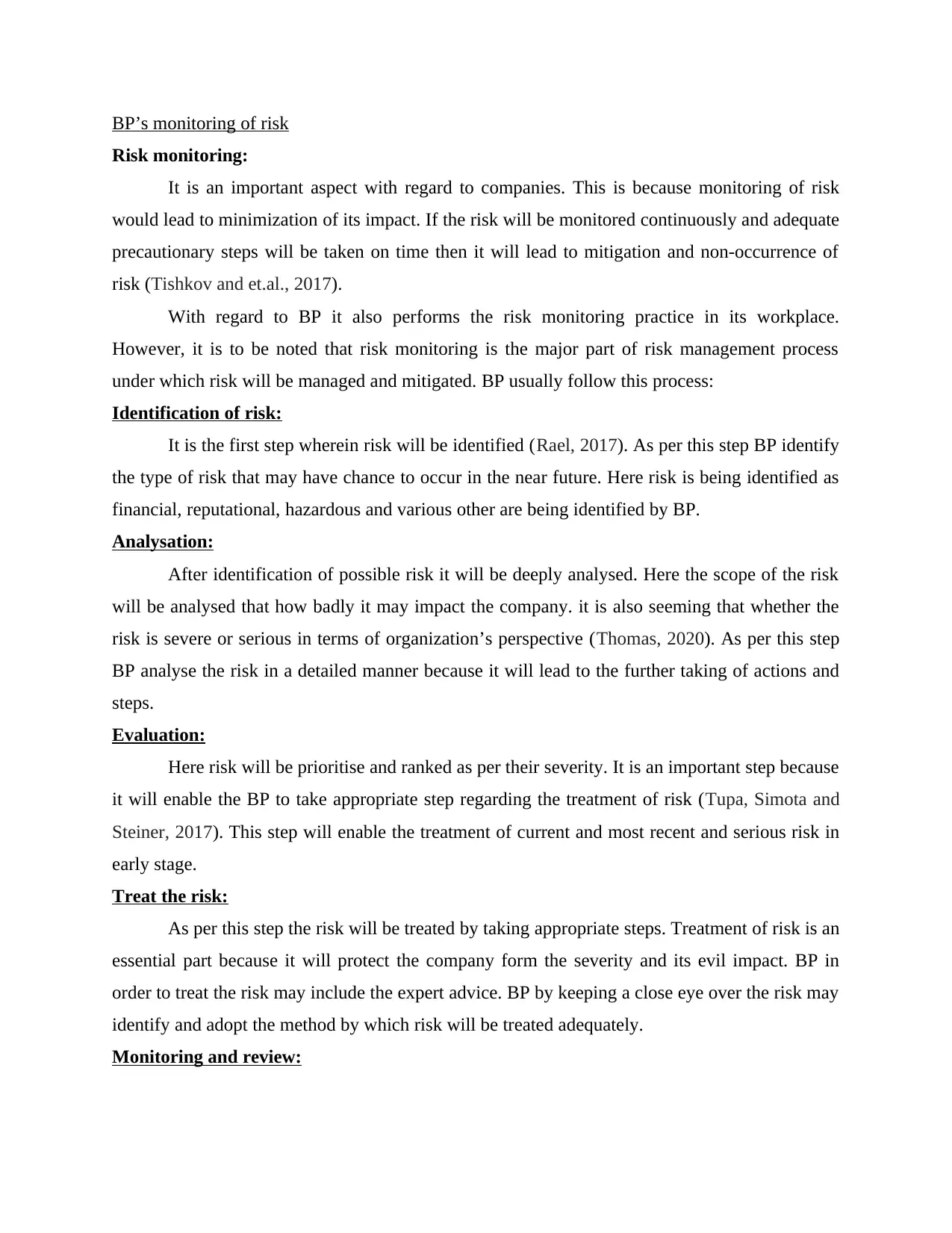
BP’s monitoring of risk
Risk monitoring:
It is an important aspect with regard to companies. This is because monitoring of risk
would lead to minimization of its impact. If the risk will be monitored continuously and adequate
precautionary steps will be taken on time then it will lead to mitigation and non-occurrence of
risk (Tishkov and et.al., 2017).
With regard to BP it also performs the risk monitoring practice in its workplace.
However, it is to be noted that risk monitoring is the major part of risk management process
under which risk will be managed and mitigated. BP usually follow this process:
Identification of risk:
It is the first step wherein risk will be identified (Rael, 2017). As per this step BP identify
the type of risk that may have chance to occur in the near future. Here risk is being identified as
financial, reputational, hazardous and various other are being identified by BP.
Analysation:
After identification of possible risk it will be deeply analysed. Here the scope of the risk
will be analysed that how badly it may impact the company. it is also seeming that whether the
risk is severe or serious in terms of organization’s perspective (Thomas, 2020). As per this step
BP analyse the risk in a detailed manner because it will lead to the further taking of actions and
steps.
Evaluation:
Here risk will be prioritise and ranked as per their severity. It is an important step because
it will enable the BP to take appropriate step regarding the treatment of risk (Tupa, Simota and
Steiner, 2017). This step will enable the treatment of current and most recent and serious risk in
early stage.
Treat the risk:
As per this step the risk will be treated by taking appropriate steps. Treatment of risk is an
essential part because it will protect the company form the severity and its evil impact. BP in
order to treat the risk may include the expert advice. BP by keeping a close eye over the risk may
identify and adopt the method by which risk will be treated adequately.
Monitoring and review:
Risk monitoring:
It is an important aspect with regard to companies. This is because monitoring of risk
would lead to minimization of its impact. If the risk will be monitored continuously and adequate
precautionary steps will be taken on time then it will lead to mitigation and non-occurrence of
risk (Tishkov and et.al., 2017).
With regard to BP it also performs the risk monitoring practice in its workplace.
However, it is to be noted that risk monitoring is the major part of risk management process
under which risk will be managed and mitigated. BP usually follow this process:
Identification of risk:
It is the first step wherein risk will be identified (Rael, 2017). As per this step BP identify
the type of risk that may have chance to occur in the near future. Here risk is being identified as
financial, reputational, hazardous and various other are being identified by BP.
Analysation:
After identification of possible risk it will be deeply analysed. Here the scope of the risk
will be analysed that how badly it may impact the company. it is also seeming that whether the
risk is severe or serious in terms of organization’s perspective (Thomas, 2020). As per this step
BP analyse the risk in a detailed manner because it will lead to the further taking of actions and
steps.
Evaluation:
Here risk will be prioritise and ranked as per their severity. It is an important step because
it will enable the BP to take appropriate step regarding the treatment of risk (Tupa, Simota and
Steiner, 2017). This step will enable the treatment of current and most recent and serious risk in
early stage.
Treat the risk:
As per this step the risk will be treated by taking appropriate steps. Treatment of risk is an
essential part because it will protect the company form the severity and its evil impact. BP in
order to treat the risk may include the expert advice. BP by keeping a close eye over the risk may
identify and adopt the method by which risk will be treated adequately.
Monitoring and review:
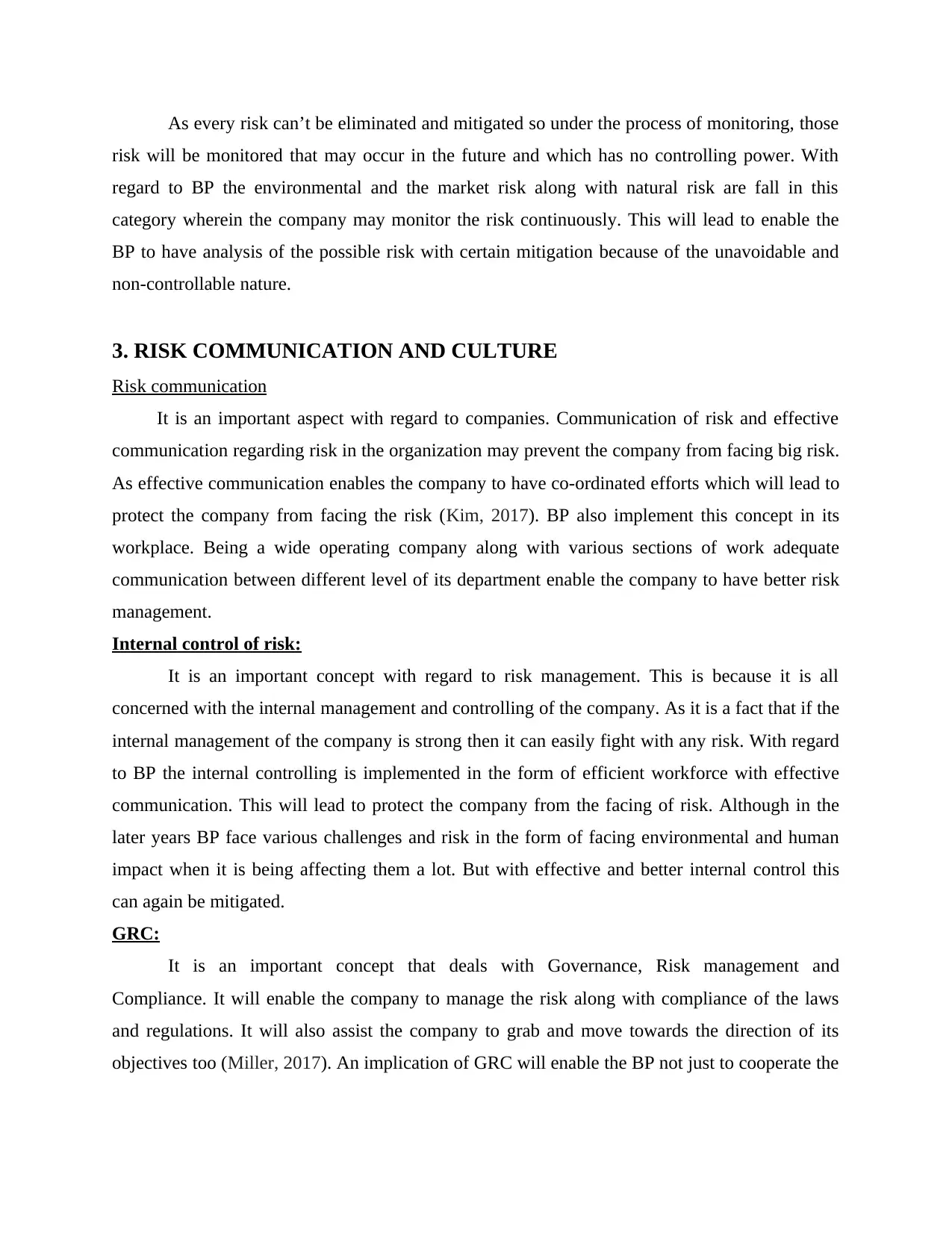
As every risk can’t be eliminated and mitigated so under the process of monitoring, those
risk will be monitored that may occur in the future and which has no controlling power. With
regard to BP the environmental and the market risk along with natural risk are fall in this
category wherein the company may monitor the risk continuously. This will lead to enable the
BP to have analysis of the possible risk with certain mitigation because of the unavoidable and
non-controllable nature.
3. RISK COMMUNICATION AND CULTURE
Risk communication
It is an important aspect with regard to companies. Communication of risk and effective
communication regarding risk in the organization may prevent the company from facing big risk.
As effective communication enables the company to have co-ordinated efforts which will lead to
protect the company from facing the risk (Kim, 2017). BP also implement this concept in its
workplace. Being a wide operating company along with various sections of work adequate
communication between different level of its department enable the company to have better risk
management.
Internal control of risk:
It is an important concept with regard to risk management. This is because it is all
concerned with the internal management and controlling of the company. As it is a fact that if the
internal management of the company is strong then it can easily fight with any risk. With regard
to BP the internal controlling is implemented in the form of efficient workforce with effective
communication. This will lead to protect the company from the facing of risk. Although in the
later years BP face various challenges and risk in the form of facing environmental and human
impact when it is being affecting them a lot. But with effective and better internal control this
can again be mitigated.
GRC:
It is an important concept that deals with Governance, Risk management and
Compliance. It will enable the company to manage the risk along with compliance of the laws
and regulations. It will also assist the company to grab and move towards the direction of its
objectives too (Miller, 2017). An implication of GRC will enable the BP not just to cooperate the
risk will be monitored that may occur in the future and which has no controlling power. With
regard to BP the environmental and the market risk along with natural risk are fall in this
category wherein the company may monitor the risk continuously. This will lead to enable the
BP to have analysis of the possible risk with certain mitigation because of the unavoidable and
non-controllable nature.
3. RISK COMMUNICATION AND CULTURE
Risk communication
It is an important aspect with regard to companies. Communication of risk and effective
communication regarding risk in the organization may prevent the company from facing big risk.
As effective communication enables the company to have co-ordinated efforts which will lead to
protect the company from facing the risk (Kim, 2017). BP also implement this concept in its
workplace. Being a wide operating company along with various sections of work adequate
communication between different level of its department enable the company to have better risk
management.
Internal control of risk:
It is an important concept with regard to risk management. This is because it is all
concerned with the internal management and controlling of the company. As it is a fact that if the
internal management of the company is strong then it can easily fight with any risk. With regard
to BP the internal controlling is implemented in the form of efficient workforce with effective
communication. This will lead to protect the company from the facing of risk. Although in the
later years BP face various challenges and risk in the form of facing environmental and human
impact when it is being affecting them a lot. But with effective and better internal control this
can again be mitigated.
GRC:
It is an important concept that deals with Governance, Risk management and
Compliance. It will enable the company to manage the risk along with compliance of the laws
and regulations. It will also assist the company to grab and move towards the direction of its
objectives too (Miller, 2017). An implication of GRC will enable the BP not just to cooperate the
⊘ This is a preview!⊘
Do you want full access?
Subscribe today to unlock all pages.

Trusted by 1+ million students worldwide
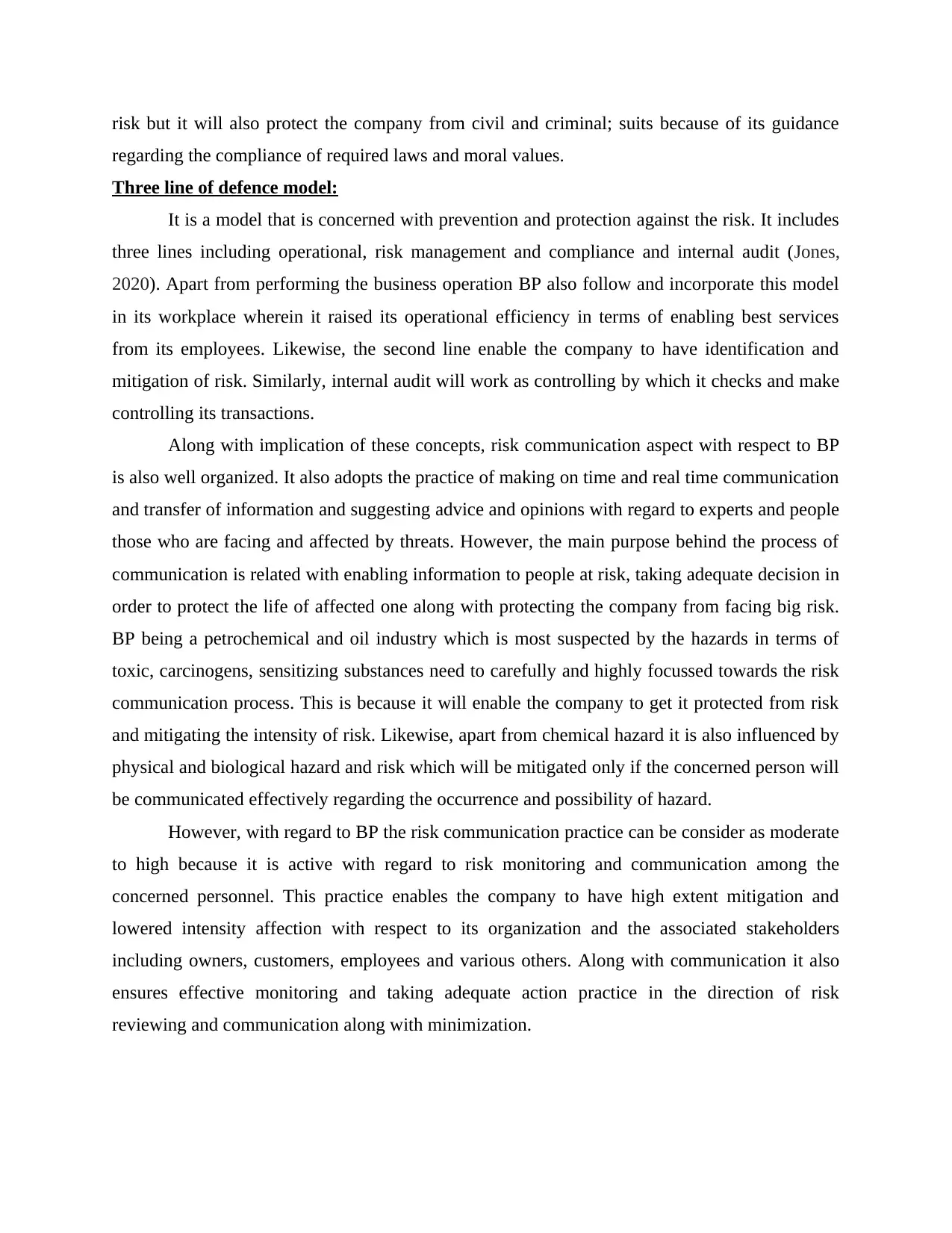
risk but it will also protect the company from civil and criminal; suits because of its guidance
regarding the compliance of required laws and moral values.
Three line of defence model:
It is a model that is concerned with prevention and protection against the risk. It includes
three lines including operational, risk management and compliance and internal audit (Jones,
2020). Apart from performing the business operation BP also follow and incorporate this model
in its workplace wherein it raised its operational efficiency in terms of enabling best services
from its employees. Likewise, the second line enable the company to have identification and
mitigation of risk. Similarly, internal audit will work as controlling by which it checks and make
controlling its transactions.
Along with implication of these concepts, risk communication aspect with respect to BP
is also well organized. It also adopts the practice of making on time and real time communication
and transfer of information and suggesting advice and opinions with regard to experts and people
those who are facing and affected by threats. However, the main purpose behind the process of
communication is related with enabling information to people at risk, taking adequate decision in
order to protect the life of affected one along with protecting the company from facing big risk.
BP being a petrochemical and oil industry which is most suspected by the hazards in terms of
toxic, carcinogens, sensitizing substances need to carefully and highly focussed towards the risk
communication process. This is because it will enable the company to get it protected from risk
and mitigating the intensity of risk. Likewise, apart from chemical hazard it is also influenced by
physical and biological hazard and risk which will be mitigated only if the concerned person will
be communicated effectively regarding the occurrence and possibility of hazard.
However, with regard to BP the risk communication practice can be consider as moderate
to high because it is active with regard to risk monitoring and communication among the
concerned personnel. This practice enables the company to have high extent mitigation and
lowered intensity affection with respect to its organization and the associated stakeholders
including owners, customers, employees and various others. Along with communication it also
ensures effective monitoring and taking adequate action practice in the direction of risk
reviewing and communication along with minimization.
regarding the compliance of required laws and moral values.
Three line of defence model:
It is a model that is concerned with prevention and protection against the risk. It includes
three lines including operational, risk management and compliance and internal audit (Jones,
2020). Apart from performing the business operation BP also follow and incorporate this model
in its workplace wherein it raised its operational efficiency in terms of enabling best services
from its employees. Likewise, the second line enable the company to have identification and
mitigation of risk. Similarly, internal audit will work as controlling by which it checks and make
controlling its transactions.
Along with implication of these concepts, risk communication aspect with respect to BP
is also well organized. It also adopts the practice of making on time and real time communication
and transfer of information and suggesting advice and opinions with regard to experts and people
those who are facing and affected by threats. However, the main purpose behind the process of
communication is related with enabling information to people at risk, taking adequate decision in
order to protect the life of affected one along with protecting the company from facing big risk.
BP being a petrochemical and oil industry which is most suspected by the hazards in terms of
toxic, carcinogens, sensitizing substances need to carefully and highly focussed towards the risk
communication process. This is because it will enable the company to get it protected from risk
and mitigating the intensity of risk. Likewise, apart from chemical hazard it is also influenced by
physical and biological hazard and risk which will be mitigated only if the concerned person will
be communicated effectively regarding the occurrence and possibility of hazard.
However, with regard to BP the risk communication practice can be consider as moderate
to high because it is active with regard to risk monitoring and communication among the
concerned personnel. This practice enables the company to have high extent mitigation and
lowered intensity affection with respect to its organization and the associated stakeholders
including owners, customers, employees and various others. Along with communication it also
ensures effective monitoring and taking adequate action practice in the direction of risk
reviewing and communication along with minimization.
Paraphrase This Document
Need a fresh take? Get an instant paraphrase of this document with our AI Paraphraser
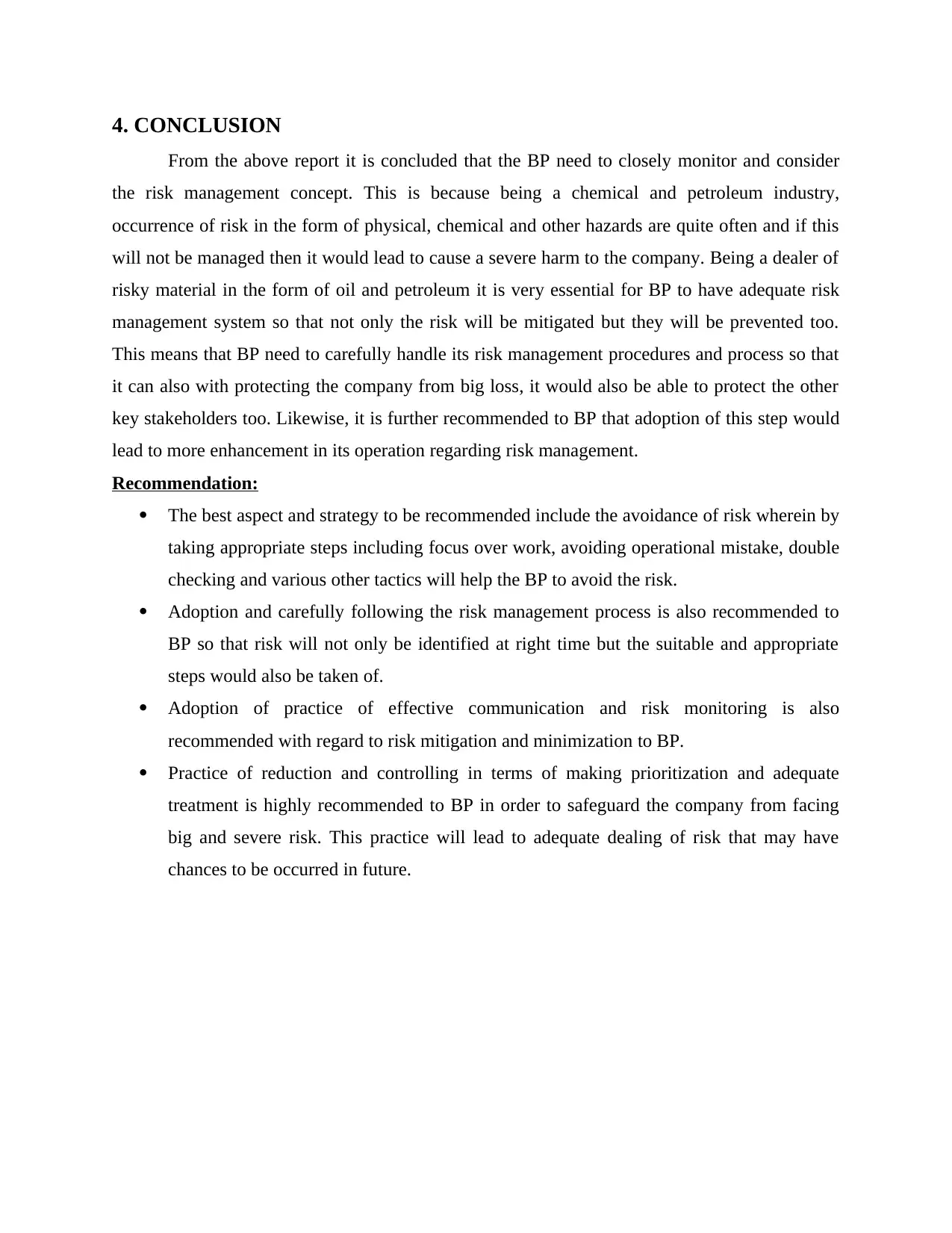
4. CONCLUSION
From the above report it is concluded that the BP need to closely monitor and consider
the risk management concept. This is because being a chemical and petroleum industry,
occurrence of risk in the form of physical, chemical and other hazards are quite often and if this
will not be managed then it would lead to cause a severe harm to the company. Being a dealer of
risky material in the form of oil and petroleum it is very essential for BP to have adequate risk
management system so that not only the risk will be mitigated but they will be prevented too.
This means that BP need to carefully handle its risk management procedures and process so that
it can also with protecting the company from big loss, it would also be able to protect the other
key stakeholders too. Likewise, it is further recommended to BP that adoption of this step would
lead to more enhancement in its operation regarding risk management.
Recommendation:
The best aspect and strategy to be recommended include the avoidance of risk wherein by
taking appropriate steps including focus over work, avoiding operational mistake, double
checking and various other tactics will help the BP to avoid the risk.
Adoption and carefully following the risk management process is also recommended to
BP so that risk will not only be identified at right time but the suitable and appropriate
steps would also be taken of.
Adoption of practice of effective communication and risk monitoring is also
recommended with regard to risk mitigation and minimization to BP.
Practice of reduction and controlling in terms of making prioritization and adequate
treatment is highly recommended to BP in order to safeguard the company from facing
big and severe risk. This practice will lead to adequate dealing of risk that may have
chances to be occurred in future.
From the above report it is concluded that the BP need to closely monitor and consider
the risk management concept. This is because being a chemical and petroleum industry,
occurrence of risk in the form of physical, chemical and other hazards are quite often and if this
will not be managed then it would lead to cause a severe harm to the company. Being a dealer of
risky material in the form of oil and petroleum it is very essential for BP to have adequate risk
management system so that not only the risk will be mitigated but they will be prevented too.
This means that BP need to carefully handle its risk management procedures and process so that
it can also with protecting the company from big loss, it would also be able to protect the other
key stakeholders too. Likewise, it is further recommended to BP that adoption of this step would
lead to more enhancement in its operation regarding risk management.
Recommendation:
The best aspect and strategy to be recommended include the avoidance of risk wherein by
taking appropriate steps including focus over work, avoiding operational mistake, double
checking and various other tactics will help the BP to avoid the risk.
Adoption and carefully following the risk management process is also recommended to
BP so that risk will not only be identified at right time but the suitable and appropriate
steps would also be taken of.
Adoption of practice of effective communication and risk monitoring is also
recommended with regard to risk mitigation and minimization to BP.
Practice of reduction and controlling in terms of making prioritization and adequate
treatment is highly recommended to BP in order to safeguard the company from facing
big and severe risk. This practice will lead to adequate dealing of risk that may have
chances to be occurred in future.

⊘ This is a preview!⊘
Do you want full access?
Subscribe today to unlock all pages.

Trusted by 1+ million students worldwide
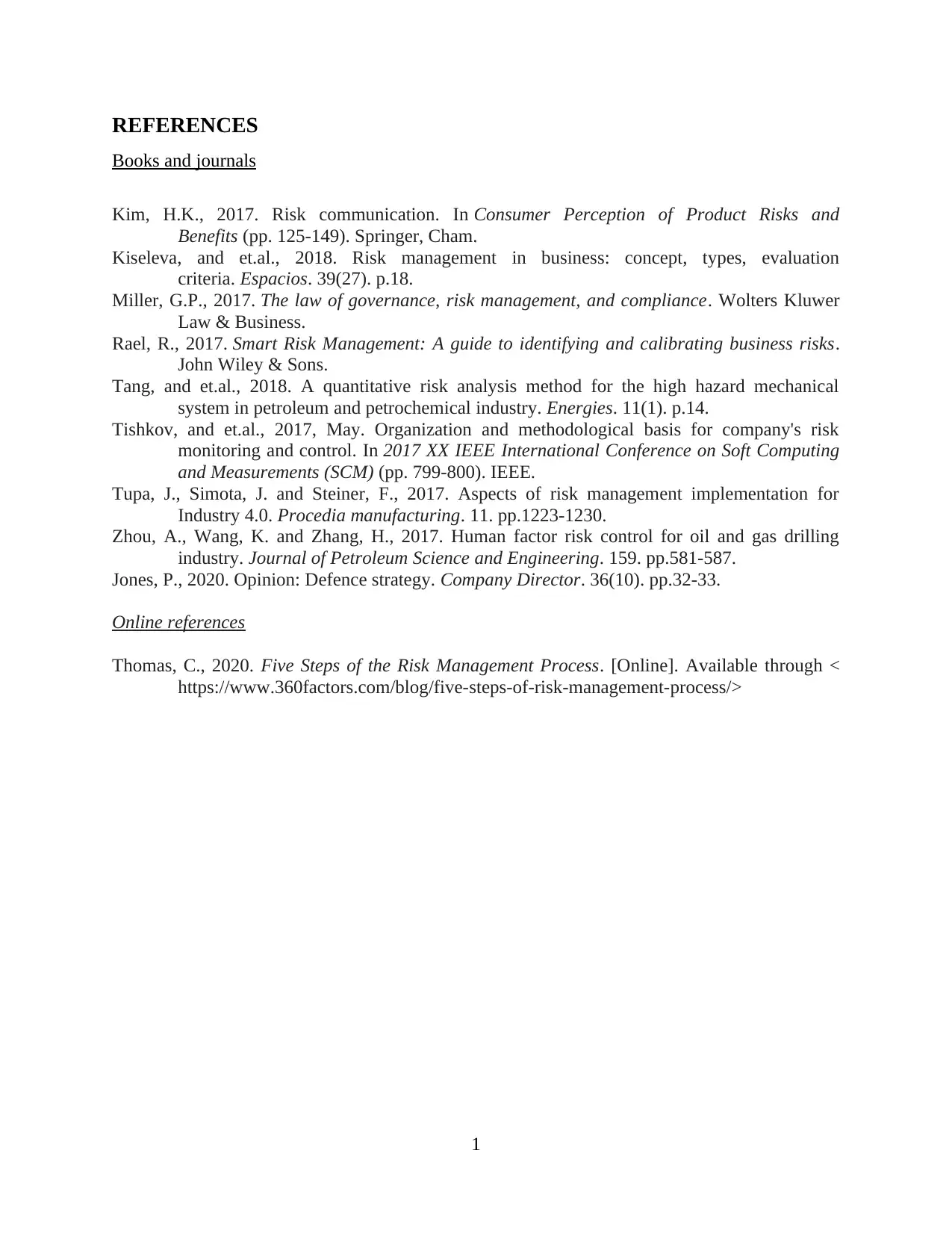
REFERENCES
Books and journals
Kim, H.K., 2017. Risk communication. In Consumer Perception of Product Risks and
Benefits (pp. 125-149). Springer, Cham.
Kiseleva, and et.al., 2018. Risk management in business: concept, types, evaluation
criteria. Espacios. 39(27). p.18.
Miller, G.P., 2017. The law of governance, risk management, and compliance. Wolters Kluwer
Law & Business.
Rael, R., 2017. Smart Risk Management: A guide to identifying and calibrating business risks.
John Wiley & Sons.
Tang, and et.al., 2018. A quantitative risk analysis method for the high hazard mechanical
system in petroleum and petrochemical industry. Energies. 11(1). p.14.
Tishkov, and et.al., 2017, May. Organization and methodological basis for company's risk
monitoring and control. In 2017 XX IEEE International Conference on Soft Computing
and Measurements (SCM) (pp. 799-800). IEEE.
Tupa, J., Simota, J. and Steiner, F., 2017. Aspects of risk management implementation for
Industry 4.0. Procedia manufacturing. 11. pp.1223-1230.
Zhou, A., Wang, K. and Zhang, H., 2017. Human factor risk control for oil and gas drilling
industry. Journal of Petroleum Science and Engineering. 159. pp.581-587.
Jones, P., 2020. Opinion: Defence strategy. Company Director. 36(10). pp.32-33.
Online references
Thomas, C., 2020. Five Steps of the Risk Management Process. [Online]. Available through <
https://www.360factors.com/blog/five-steps-of-risk-management-process/>
1
Books and journals
Kim, H.K., 2017. Risk communication. In Consumer Perception of Product Risks and
Benefits (pp. 125-149). Springer, Cham.
Kiseleva, and et.al., 2018. Risk management in business: concept, types, evaluation
criteria. Espacios. 39(27). p.18.
Miller, G.P., 2017. The law of governance, risk management, and compliance. Wolters Kluwer
Law & Business.
Rael, R., 2017. Smart Risk Management: A guide to identifying and calibrating business risks.
John Wiley & Sons.
Tang, and et.al., 2018. A quantitative risk analysis method for the high hazard mechanical
system in petroleum and petrochemical industry. Energies. 11(1). p.14.
Tishkov, and et.al., 2017, May. Organization and methodological basis for company's risk
monitoring and control. In 2017 XX IEEE International Conference on Soft Computing
and Measurements (SCM) (pp. 799-800). IEEE.
Tupa, J., Simota, J. and Steiner, F., 2017. Aspects of risk management implementation for
Industry 4.0. Procedia manufacturing. 11. pp.1223-1230.
Zhou, A., Wang, K. and Zhang, H., 2017. Human factor risk control for oil and gas drilling
industry. Journal of Petroleum Science and Engineering. 159. pp.581-587.
Jones, P., 2020. Opinion: Defence strategy. Company Director. 36(10). pp.32-33.
Online references
Thomas, C., 2020. Five Steps of the Risk Management Process. [Online]. Available through <
https://www.360factors.com/blog/five-steps-of-risk-management-process/>
1
Paraphrase This Document
Need a fresh take? Get an instant paraphrase of this document with our AI Paraphraser

2
1 out of 11
Related Documents
Your All-in-One AI-Powered Toolkit for Academic Success.
+13062052269
info@desklib.com
Available 24*7 on WhatsApp / Email
![[object Object]](/_next/static/media/star-bottom.7253800d.svg)
Unlock your academic potential
Copyright © 2020–2025 A2Z Services. All Rights Reserved. Developed and managed by ZUCOL.





